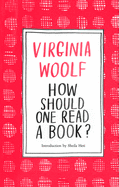
Virginia Woolf's How Should One Read a Book? is an essay for both readers and writers, and this new edition is available as a standalone essay for the first time, framed with an introduction and afterword by Sheila Heti (How Should a Person Be?).
Woolf's text recalls the inherent joys of different kinds of reading--no matter what any critics might have to say on the matter. Woolf writes about the personal nature of reading, and how it can be done "to refresh and exercise our own creative powers" as well as to become acquainted with great literary works and those who create them. She notes that reading is not about a single text, but that the pleasure of reading is best understood through comparison of many texts, in order to reveal not only one's tastes but, through what readers choose what to read, to provide feedback about literary tastes to the authors who continue to write. Similarly, it is readers' personal reactions to literature that Woolf holds as more important, as "books pass in review like the procession of animals in a shooting gallery, and the critic has only one second in which to load and aim and shoot" and thus, might be prone to mistakes in influence.
With lines like, "The shape of the book ends up being some alchemy between the shape the writer created and the shape of our life as we read it," Heti's introduction meditates on the core of Woolf's essay: the connections and spaces between authors and readers, built by readers, where meaning is made. --Michelle Anya Anjirbag, freelance reviewer

